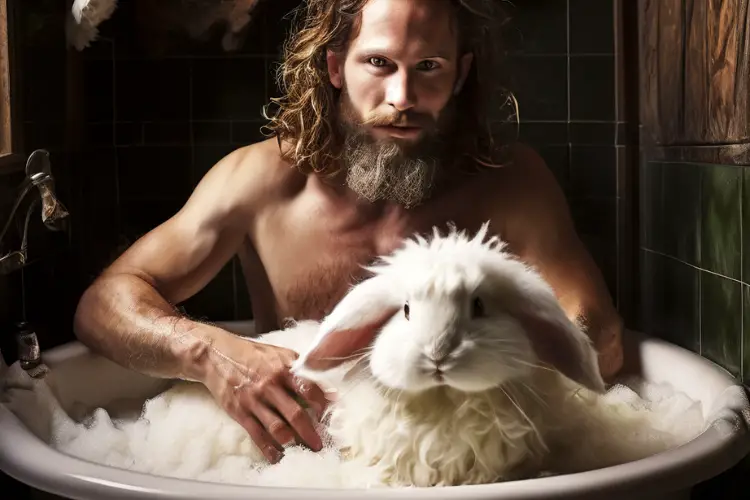As an Angora rabbit owner, you know how important it is to keep your furry friend’s coat in pristine condition. Regular grooming is essential, but sometimes a bath is necessary to remove stubborn dirt, dander, and loose hair.
However, bathing an Angora rabbit can be a daunting task if you’re not familiar with the proper techniques.
In this blog post guide, we’ll walk you through the step-by-step process of safely bathing your Angora rabbit, ensuring a stress-free experience for both you and your beloved pet.
Why Bathe an Angora Rabbit?
Angora rabbits are known for their luxurious, soft coats, which require meticulous grooming to prevent matting and maintain their overall health. While regular brushing is essential, bathing becomes necessary under certain circumstances:
1. Excessive Shedding: During molting seasons, Angora rabbits shed a significant amount of fur, which can become trapped in their coat, leading to matting and potential health issues.
2. Soiled Coat: If your Angora rabbit has gotten into something messy or soiled its coat, a bath may be required to remove the debris and prevent further matting or skin irritation.
3. Dander and Odor Control: Angora rabbits can accumulate dander and develop a distinctive odor, which can be minimized by occasional bathing.
4. Preparing for Shows: If you plan to enter your Angora rabbit in a show or competition, a bath can help enhance the coat’s appearance and overall presentation.
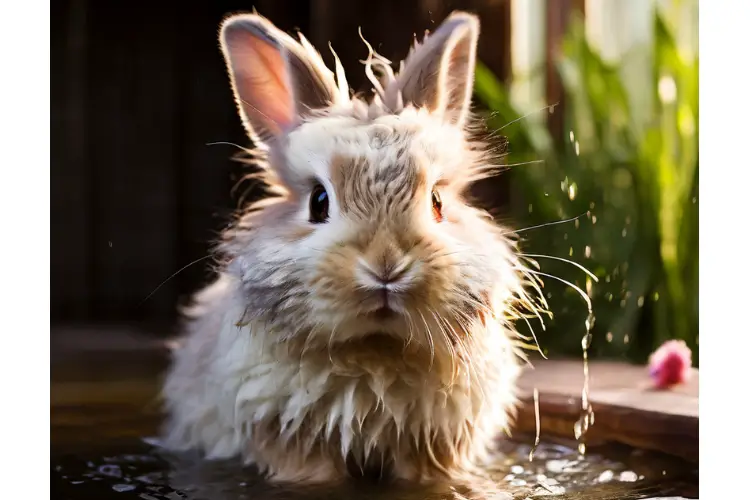
Preparing for the Bath
Before you begin the bathing process, it’s essential to prepare the necessary supplies and create a safe, stress-free environment for your Angora rabbit.
Supplies Needed:
- A non-slip surface or mat to prevent your rabbit from slipping in the tub or sink
- A rabbit-safe shampoo (avoid using human shampoos, as they can be too harsh for your rabbit’s sensitive skin)
- A spray bottle filled with lukewarm water
- Multiple clean, soft towels for drying
- A brush or comb specifically designed for Angora rabbits
- A non-slip mat or towel for the drying area
- Treats or your rabbit’s favorite snack as a reward
Creating a Calm Environment:
Rabbits are prey animals and can easily become stressed in unfamiliar situations. To ensure a smooth bathing experience, follow these tips:
1. Choose a Quiet Time: Bathe your rabbit during a time when there are minimal distractions or loud noises that could startle them.
2. Prepare the Area: Set up the bathing area in a warm, draft-free room, such as a bathroom or laundry room. Make sure the water temperature is lukewarm, as rabbits are sensitive to extreme temperatures.
3. Provide Comfort: Place a soft towel or blanket in the bathing area, so your rabbit feels secure and comfortable while being bathed.
4. Speak Softly: Maintain a calm, soothing voice throughout the bathing process to help your rabbit stay relaxed.
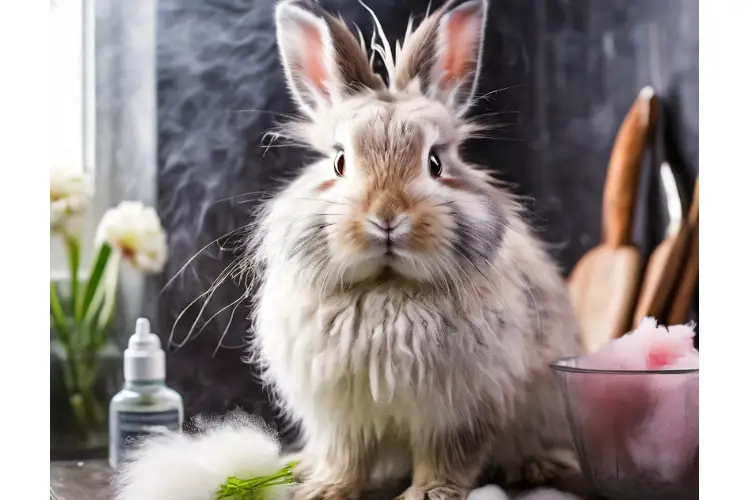
Step-by-Step Guide to Bathing Your Angora Rabbit
Now that you’ve prepared the necessary supplies and environment, it’s time to begin the bathing process. Follow these steps carefully to ensure your Angora rabbit’s safety and comfort.
Step 1: Brush Your Rabbit
Before bathing, it’s essential to brush your Angora rabbit thoroughly to remove any loose hair, dander, and matted fur. Use a slicker brush or a wide-toothed comb designed specifically for Angora rabbits. Start from the head and work your way down the body, gently brushing in the direction of the fur growth.
Step 2: Fill the Tub or Sink
Fill a bathtub or sink with a few inches of lukewarm water. Ensure the water temperature is comfortable for your rabbit by testing it with your wrist or elbow. Avoid using hot water, as it can scald your rabbit’s sensitive skin.
Step 3: Wet Your Rabbit
Gently place your rabbit in the tub or sink, and use the spray bottle to wet their fur, starting from the neck and working your way down. Be careful not to spray water directly into your rabbit’s face or ears, as this can startle them and cause stress.
Step 4: Apply Shampoo
Apply a small amount of rabbit-safe shampoo to your rabbit’s fur, starting from the neck and working your way down. Gently lather the shampoo into the fur, taking care to avoid getting any soap in your rabbit’s eyes, ears, or mouth.
Step 5: Rinse Thoroughly
Once you’ve lathered your rabbit’s fur, it’s time to rinse. Use the spray bottle or a gentle stream of lukewarm water to remove all traces of shampoo from your rabbit’s coat. Be sure to rinse thoroughly, as any remaining soap can cause skin irritation or dryness.
Step 6: Dry Your Rabbit
After rinsing, carefully lift your rabbit out of the tub or sink and wrap them in a clean, dry towel. Gently pat and squeeze the towel to absorb excess water from their fur. Avoid rubbing or vigorously towel-drying, as this can cause matting or damage to their delicate coat.
Step 7: Brush and Dry
Once your rabbit is partially dried with the towel, place them on a non-slip mat or towel in a warm, draft-free area. Use a brush or comb to gently detangle and separate their fur while it dries. You can also use a low-heat setting on a hair dryer, held at a safe distance, to help speed up the drying process.
Step 8: Offer a Treat and Praise
After the bathing and drying process is complete, reward your rabbit with a favorite treat and plenty of praise for their cooperation. This positive reinforcement will help your rabbit associate bathing with a pleasant experience, making future baths easier for both of you.
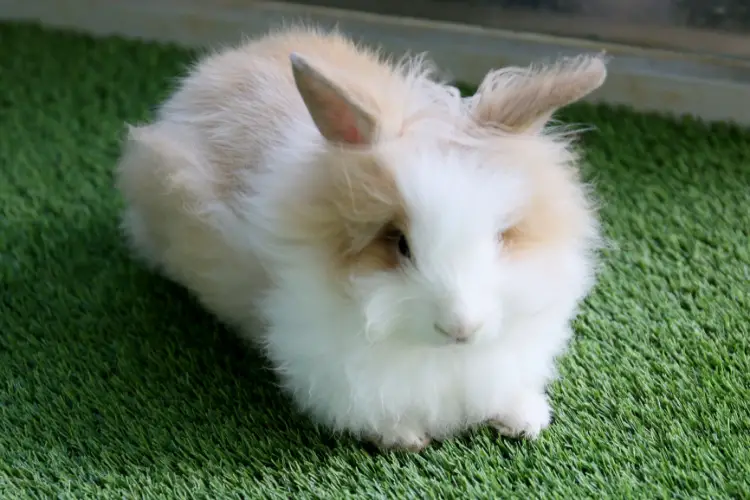
Tips for a Successful Angora Rabbit Bath
To ensure a smooth and stress-free bathing experience for you and your Angora rabbit, keep the following tips in mind:
1. Remain Calm and Patient: Rabbits can sense your emotions, so it’s important to stay calm and patient throughout the bathing process. If your rabbit becomes overly stressed or agitated, it’s best to stop and try again another day.
2. Avoid Getting Water in the Ears and Eyes: Water in your rabbit’s ears or eyes can lead to infections or discomfort. Be extra careful when wetting and rinsing your rabbit’s head area.
3. Use Rabbit-Safe Products: Never use human shampoos or other grooming products on your Angora rabbit. Stick to products specifically formulated for rabbits to avoid potential skin irritations or health issues.
4. Check for Matted Fur: During the bathing process, carefully check for any matted or tangled fur. If you find any mats, gently work them out with your fingers or a wide-toothed comb while the fur is wet and easier to detangle.
5. Dry Thoroughly: Ensure your rabbit is completely dry before returning them to their enclosure. Damp fur can lead to chills or skin problems, so take the time to thoroughly dry your rabbit’s coat.
6. Schedule Regular Baths: Angora rabbits typically require bathing every 6-8 weeks, depending on their individual needs and coat condition. Establish a regular bathing routine to maintain their coat health and prevent excessive matting or soiling.
When to Seek Professional Grooming
While regular bathing and grooming can be done at home, there may be times when professional grooming is necessary for your Angora rabbit. Seek the assistance of an experienced rabbit groomer if:
- Your rabbit’s coat is severely matted, and you’re unable to detangle it safely at home.
- Your rabbit has developed skin issues or irritations that require specialized treatment.
- You’re uncomfortable or unsure about properly bathing or grooming your rabbit.
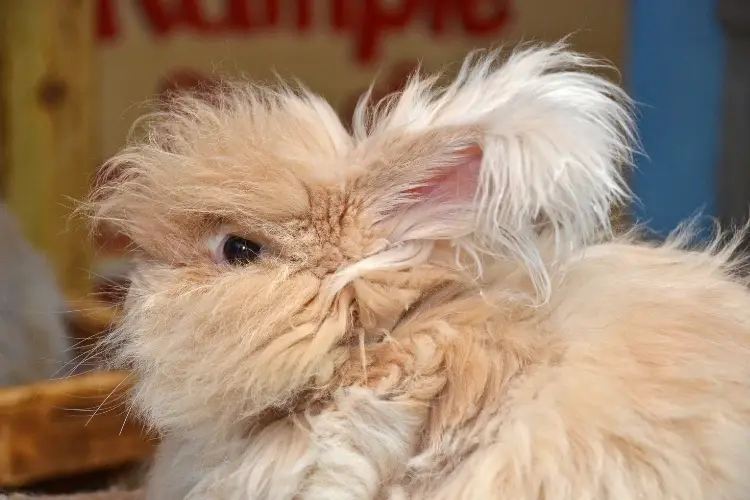
Potential Risks and Precautions
While bathing your Angora rabbit can be a safe and beneficial experience, it’s important to be aware of potential risks and take the necessary precautions to ensure your rabbit’s well-being.
1. Stress and Anxiety
Bathing can be a stressful experience for rabbits, as they are prey animals and may perceive it as a threatening situation. Prolonged stress can lead to health problems, such as digestive issues or a weakened immune system. To minimize stress, follow the steps outlined in this guide, create a calm environment, and be patient with your rabbit throughout the process.
2. Hypothermia
Rabbits are sensitive to temperature changes and can easily become chilled, especially when their fur is wet. Ensure the bathing area and drying space are warm and free from drafts. Additionally, dry your rabbit thoroughly and provide a cozy, warm enclosure for them to rest and fully dry after the bath.
3. Water Ingestion
If your rabbit ingests a significant amount of bathwater, it can lead to gastrointestinal issues or, in severe cases, life-threatening water intoxication. Be careful when wetting and rinsing your rabbit, and avoid submerging their head underwater.
4. Ear and Eye Infections
Water entering your rabbit’s ears or eyes can increase the risk of infections. Take extra care when wetting and rinsing the head area, and consider using a damp cloth or cotton balls to gently clean those sensitive areas.
5. Skin Irritations
Using the wrong shampoo or grooming products can cause skin irritations, dryness, or allergic reactions in your rabbit. Always use rabbit-safe, gentle shampoos and follow the product instructions carefully.
By being aware of these potential risks and taking the necessary precautions, you can ensure a safe and stress-free bathing experience for your Angora rabbit.
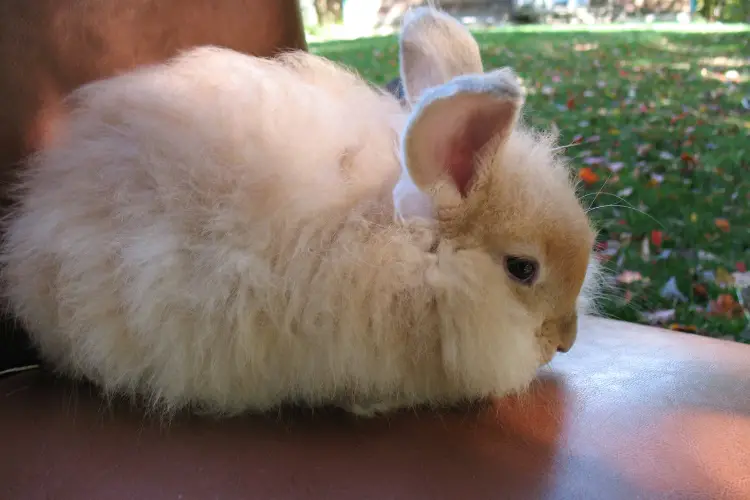
Aftercare and Maintenance
After successfully bathing your Angora rabbit, proper aftercare and maintenance are essential to keep their coat in top condition and prevent future matting or soiling.
1. Drying and Brushing
Once your rabbit is fully dry, brush their coat thoroughly to remove any remaining loose hair and help distribute natural oils evenly throughout their fur. Use a slicker brush or wide-toothed comb specifically designed for Angora rabbits, and brush in the direction of hair growth.
2. Monitoring for Matting
Even with regular brushing, Angora rabbits can develop matted fur, especially in areas prone to soiling or moisture, such as the hindquarters. Regularly check for mats and gently detangle them using your fingers or a wide-toothed comb. If mats become too severe, seek professional grooming assistance.
3. Maintaining a Clean Environment
To help keep your rabbit’s coat clean and reduce the need for frequent bathing, ensure their living space is kept tidy and free from excessive hay, litter, or other debris that could become trapped in their fur. Spot-clean any soiled areas promptly to prevent further matting or odor.
4. Monitoring for Skin Issues
After bathing, keep an eye out for any signs of skin irritation, such as redness, excessive scratching, or hair loss. If you notice any concerning symptoms, consult with your veterinarian promptly, as they may indicate an underlying health issue or allergic reaction.
By following these aftercare and maintenance steps, you can help ensure your Angora rabbit’s coat remains healthy, beautiful, and free from excessive matting or soiling between baths.
Conclusion
Bathing your Angora rabbit may seem like a daunting task, but with the right preparation, techniques, and patience, it can be a safe and stress-free experience for both you and your furry friend.
By following the step-by-step guide outlined in this article, creating a calm environment, and using rabbit-safe grooming products, you can ensure your Angora rabbit’s coat stays in pristine condition while promoting their overall health and well-being.
Remember, regular grooming and bathing are essential for Angora rabbits, and seeking professional assistance from an experienced groomer is recommended for severe matting or skin issues. With proper care and maintenance, your Angora rabbit’s luxurious coat will continue to be a source of pride and joy for years to come.

